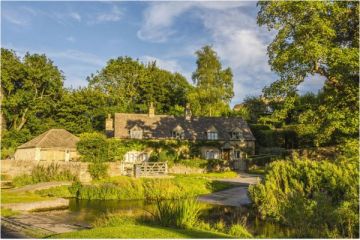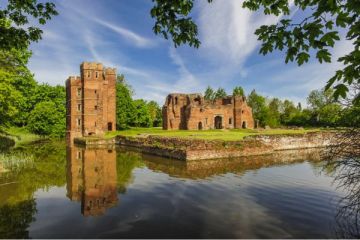by Patricia Latford

A short distance northwest of London lies the town of Amersham in the rolling hills of Buckinghamshire. It can easily be reached either by tube on the Metropolitan line, by Green Line coach or by car on the A413 out of London.
The town has two parts, the new - Amersham on the Hill - and the old - Amersham Old Town. A lot of history has passed through this small town. It has one main street, called High Street with a few smaller lanes on each side.
A town was on this site in Saxon times called "Agmodesham" and later there was trouble with the Danes in the area. The Domesday Book listed the town as "Elmodesham" with six manors, one belonging to Edith, the wife of Edward the Confessor.
In 1200 King John granted to the town a market and fair to be held every year which is still an annual event. The Reformation had some roots in the town as several Lollards were condemned to death and burned at the stake - hence the memorial on the hill.
Walking up High Street from the bus depot at the edge of town, you will immediately see a large hill across the road to your left. This is called Gore Hill, named for a battle against the Danes.
Just to the side of the road that leads over the hill is Bury Farm, dating from the1660’s. This was the Quaker home of the Isaac and Mary Pennington and it was here William Penn, founder of Pennsylvania, came courting his future wife, Gulielma Springett, Mary’s daughter.
Notice the sign at No.60 London Road. It threatens “dire penalties to ballad mongers and other vagrants”. Shortly you come to the Griffin Hotel, once an important staging post. It is older than it looks from the front as it was altered late in the l7th century. It was here that some of Cromwell’s troops were stationed during the Civil War.
Walk to the back to see the earlier Elizabethan structure. Turn up Whielden Street and you will notice a large building on the left. This is part of a 17th-century workhouse where forty inmates were engaged in, among other occupations, lacemaking and spinning, the rate of pay for which was “a farthing (1/4 of a penny) for every 100 turns of the wheel”.
Go back to the High Street, turn left and continue on, noticing the Market Hall in the middle of the road. This building was given to the town in 1682 by Sir William Drake. The market was held beneath the structure with town meetings upstairs, which continues to this day.
Just up from this is the Crown Hotel which was another important staging post. Go inside for refreshment in its pub and look around. The restaurant offers some good English dishes as well. The front of the hotel is Georgian but the inside is Elizabethan with rich panelling, large beams and snug inglenooks.
The wall paintings are Elizabethan and the lounge shows the Royal Arms commemorating Queen Elizabeth I’s visit to the town. There is a ghost, of course. It has been seen several times, when the pub is empty, leaning against one of the old posts. Some people have felt the presence of a spirit while sitting in one of the booths and the wall pictures were seen to move.
Outside again and continuing on notice No. 42, the Elmodesham House, the name being in the Domesday Book of 1086. This is the largest house in town. It was used as a boarding school in the last century and today it houses Council offices. Take a moment from here to look across the street and notice the rooflines of the different architecture styles.
Next of importance are six small houses called Drake’s Almshouses, erected in 1657 by William Drake to house six poor women of the parish, widows over fifty years of age. Among their benefits were “a gown of London brown at Christmas each year for the first three years and alternate years thereafter; a pair of shoes, a pair of stockings and a shift twice a year at Christmas and Easter; and a load of billets four feet in length each year for firings”. Billets were used as firewood.
Next, you will see a pathway called Cherry Lane. Take this to the top of the hill and turn left, walking down the road for a short distance enjoying the pretty homes until suddenly appearing on your left will be a tiny black and white half-timbered cottage called Chimney Cottage. It dates from the 17th century and if it seems a little familiar to you it’s because it has been pictured on many calendars as it is considered the most picturesque dwelling in Amersham especially when its garden is in bloom. It consists of two rooms with a chimney at either end.
Now go back the way you came to the High Street and continue left. Another large house is Little Shardeloes, Tudor in origin, but now altered. It is believed to be the Amersham Manor before 1637 when William Drake purchased it for the family as the Dower House.
Crossing the street again, you will see the building called the Town Mill, operating early in the 17th century as a corn mill until about 60 years ago. Next of interest are several houses called Turpin’s Row and dating from 1678. Many years ago this section would be full of straw-plaiting by the women and children to help out with the meagre wages of the men. Further down the street is a little house which seems squeezed between its neighbours. This is just big enough inside for one person to live comfortably with a pretty garden of some size out back.
Now look across the street at the rooflines of the buildings on the other side to notice the difference in styles. Walking back past the Market Hall turn left onto Church Street. On your right will be the church of St. Mary’s.
Hopefully, it will be open and you can go inside for a look around. There are some interesting monuments, especially in the Drake Chapel, and notice the east window. Parts of the church date back to the 13th century.
Outside again continue on up the street and you will pass what used to be the brewery for 150 years which gave employment to many of the town’s men. It closed in 1929 and is now a cosmetics factory. Going on up the hill at the top is a large home known as the Rectory. It was built about 1725.
Take the little road to your right that leads to the graveyard and follow the footpath around the low end and up onto the hill walking to the right and on to the Martyrs’ Memorial. This commemorates the six Amersham men and one woman who, in the early years of the 16th century were burned at the stake for their faith as Lollards.
This also gives excellent views of the town that you have just walked through. As you face the town, notice to the right, off some distance, is a large manor home called Shardeloes. This was the ancestral home of the Tyrwhitt Drake family. Sadly, now the house has been converted into flats.
An interesting bit of history about the place concerns the Tyrwhitt Drake family and “the curse put on the family whereby the inheritance would never be inherited by a direct heir”. The curse was made by the family of a boy murdered at sea when in the employ of one of the Drakes. “Their coat of arms is surmounted by an axe dripping with blood and the wheels of their carriage had to be painted red! (Later red rims on their cars.)“ It is assumed this was so everyone who saw them knew who they were.
“To break the curse, a member of the family was to spend a certain length of time in an underground tunnel that runs under Shardeloes lake.” Many years ago a family member tried to break the curse and spent a period of time in the tunnel, but gave up and came out mad!
Retrace your steps down the hill from the graveyard and go into the Memorial Gardens just below the church. These were laid out by the local council to commemorate those who died in the two world wars. Exit by the wall and you are now back on the High Street.
Take time to go into the various shops in this area. Surely there is something in the pottery shop that you can take home as a memento of your trip to Amersham. Then before returning to the car park, take a few minutes to enjoy a delicious cup of tea and sweets in the nearby tea shop.
Related:
Guide to Amersham


